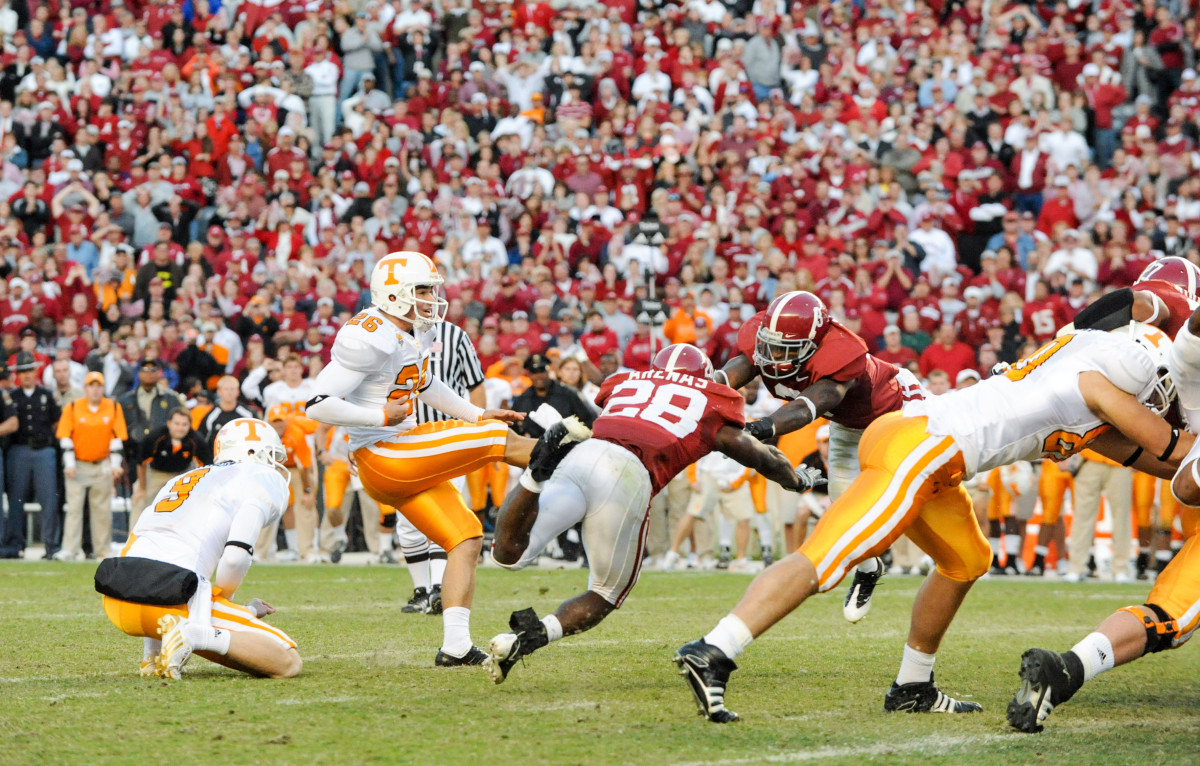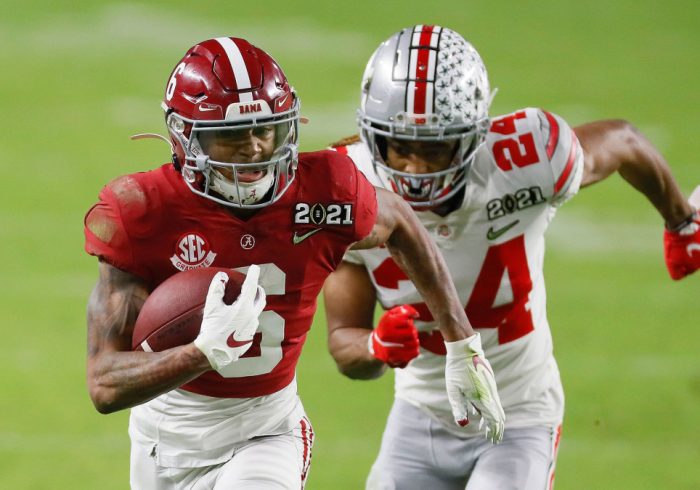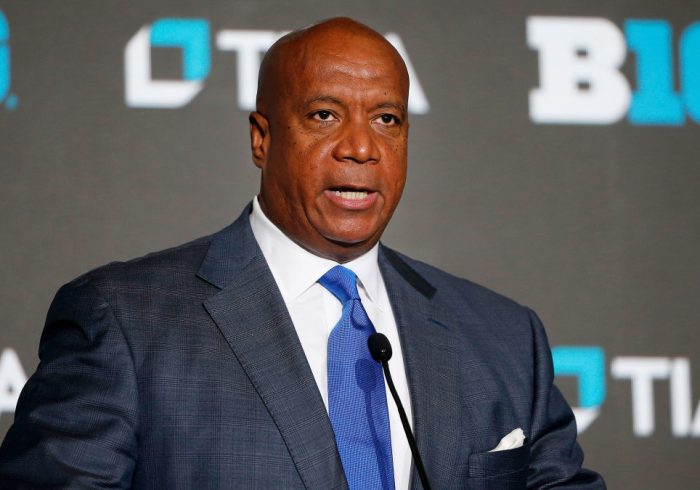The afternoon began with a headset outage, and to this day parties on both sides passive-aggressively accuse each other of gamesmanship. The clash between two college football rivals wound over a strange three hours, bereft of drama until a sudden infusion of it in the final three minutes. The contest ended with a blocked kick that literally has been framed and mounted in the winning school’s rich history.
Thereafter, the two programs went their separate ways—one to the pinnacle of college football, the other into the abyss of mediocrity. This may be the week No. 3 Alabama and No. 6 Tennessee return to equal footing. They really haven’t been there since that crossroads game in Tuscaloosa 13 years ago.
The final score at Bryant-Denny Stadium on Oct. 24, 2009, was Alabama 12, Tennessee 10. Terrence Cody—a 6’5″, 354-pound behemoth of a defensive lineman nicknamed Mount Cody—ended it by swatting down a Daniel Lincoln field goal on the final play. Winning coach Nick Saban shook hands with losing coach Lane Kiffin, and since then one of the great Southeastern Conference rivalries hasn’t been the same.
It was the Crimson Tide’s third straight win against the Volunteers, and they haven’t lost to them since. The streak is now 15 games. Tennessee is, to its eternal angst, oh-for-Saban. Alabama went on to win the national championship that season, the first of six under Saban. It was the title that launched the most dominant sustained period in the history of the sport.
In Knoxville, things went the other way. Kiffin departed at the end of his only season at Tennessee for USC, stamping himself as an eternal villain on Rocky Top. The optimism that accompanied the 34-year-old’s arrival and debut season vanished. What followed was a dismal coaching spin cycle—Derek Dooley to Butch Jones to Jeremy Pruitt—but the Vols now appear to finally be in good hands with Josh Heupel.
“Ultimately, you’ve got to get the coaches right,” says former Alabama quarterback and current ESPN analyst Greg McElroy. “They screwed the pooch a couple times.”
After Kiffin went 7–6, seven of Tennessee’s next 12 seasons ended with losing records. The 2009 Alabama game, and the rest of that season, presents an intriguing string of what-ifs.
Alabama’s Javier Arenas (28) and Terrance Cody reach in to block Daniel Lincoln’s field-goal attempt. Cody made contact, helping hand Tennessee the loss in 2009.
Gary Bogdon/Sports Illustrated
What if Lincoln’s kick had gotten over Cody’s left hand, cleared the line of scrimmage and gone through the uprights? (We’ll get to the last part of that later.)
What if Tennessee walked off with a stunning road upset of the No. 2 Tide? Would Alabama still have won the national title?
Would the BCS standings have produced one of their most controversial championship game pairings?
Would Saban’s era of dominance have been slightly delayed? Would beating hated Alabama and derailing an undefeated season have made Kiffin so popular at Tennessee that he would have wanted to stay?
Would Kiffin still have been unemployed and damaged goods, available for Saban to hire as offensive coordinator in 2014 after being fired at USC?
“Well, I’m not God, so I can’t tell you what would have happened,” Kiffin says. “I do think, later on in life, everything happens for a reason. Who knows what would have happened? Maybe it happened because if we would have made [the kick], when I went to work for Coach [Saban], I always would have been able to say when he was getting on me, ‘We beat you, 1–0.’ He was always able to hold that over me, that he was 1–0 against me.”
Perhaps not much changes if Tennessee wins in terms of the future paths of the coaches. Saban’s run was inevitable, and Kiffin might well have said yes to USC—late in the hiring cycle in January 2010—even if he had been celebrated in Knoxville for a landmark first-year upset.
“I think he takes the USC job anyway,” says 1990s Tennessee player Brad Lampley, now a Nashville-based attorney who has a son on the current team and is a former university trustee. “I think he leaves us. We probably still would have been in the wilderness. When Lane left, and left when he did, you just sort of felt the momentum fall out from underneath.”
Lampley remembers watching that 2009 game with a big group at a farm owned by one of his law partners. The law firm included some Alabama grads, so there was some jawing going on. When the kick was blocked, the party erupted—some in elation, more in horror.
“We just stood there and screamed at the TV,” Lampley says. “I’ll never forget; I said to a partner in our firm who went to Alabama, ‘We’re going to get you next year.’”
Next year, and every year since, has come and gone with a Crimson Tide victory. It’s fair to say no one in the Southeastern Conference has suffered as much as the Volunteers during Saban’s 15-year reign at Alabama. Auburn has beaten him five times, LSU four, Texas A&M, Georgia and Mississippi twice apiece, and Florida, Mississippi State—and even South Carolina—have all done it once.
But Tennessee, which has beaten Alabama 37 times in its proud history? Zero wins over that span, and most of the games were not close. There was a five-point loss in 2015, and the stunning upset opportunity of ’09 that materialized in the final minutes but got away on the final play.
The game began amid controversy, and there is still finger-pointing in both directions over it. Shortly before kickoff, according to Kiffin, the Tennessee headsets went out. That meant, by rule, Alabama could not use its headsets either.
Tennessee smelled a crimson rat. Alabama smelled an orange rat.
“Five seconds before kickoff, it was amazing how that happened,” Kiffin says. “Especially knowing that I was the play-caller on the field and had zero ability to communicate in the headsets. Just amazing how that happened right at that time. Never happened ever again for some reason over the 13–14 years of my career.”
Kiffin was one season and done at Tennessee, leaving the Vols for USC after the 2009 campaign.
Marvin Gentry/USA TODAY Sports
McElroy counters with his own suspicion that Kiffin (or someone from Tennessee) manufactured the headset outage because Alabama got the ball first. With offensive coordinator Jim McElwain in the press box, there was no way to communicate a play call to the field.
“Miraculously, Tennessee claimed the headphones didn’t work right before the game,” McElroy says. “I had to call the first three plays from memory off the pregame script. All three plays, Tennessee lined up differently than we’d seen them on film—major tendency breakers. That was the beginning of what was just kind of a weird day.”
Star safety Eric Berry blitzed and hit McElroy on third down, forcing an incompletion and a three-and-out possession. The headset issue was eventually corrected, but a game-long slog was underway. The day belonged to the defenses, which were coordinated by Kirby Smart for the Tide and Monte Kiffin (Lane’s father) for the Vols. Eventual Heisman Trophy winner Mark Ingram was held to 99 rushing yards, Alabama produced a season-low 256 total yards, and the Tide were held out of the end zone all game. But Tennessee had its own struggles finishing drives. Leigh Tiffin connected on four field goals for Alabama, the last of which produced a seemingly comfortable 12–3 lead with 6:31 to play.
“Our whole thing coming into the game was, They’re not very good on offense; just don’t do anything dumb to give them a chance,” McElroy says. “A 12–3 lead for us, with our defense? That was like a 21-point lead in 2009. We’re putting the game on ice. Then Mark, who never fumbled, put one on the deck.”
An Ingram fumble on the Alabama 43 with 3:29 left gave Tennessee a sliver of hope. The Vols drove to the Tide 11, and on third-and-5 Jonathan Crompton hit Gerald Jones for a touchdown to make it 12–10 with just more than a minute to play.
“Then they get the onside kick and it’s like, You gotta be kidding me,” McElroy says. “They didn’t do anything for 55 minutes, then suddenly they’re going like gangbusters. It all happened so suddenly.”
A nauseous anxiety gripped Bama fans, who saw a sure win slipping and their undefeated season suddenly imperiled. “We did everything wrong the last three minutes,” Saban said afterward.
From midfield, Crompton threaded a pass to tight end Luke Stocker on a seam route to the Alabama 27. A running play to improve field-goal range went nowhere, then Crompton spiked the ball to set up a 44-yard kick for the win with four seconds left.
It was no sure thing. Lincoln came into the game having made eight of 10 field goals for the season but missed one earlier in the game and got another low liner blocked by Cody’s armpit. Saban called timeout to ice Lincoln, and the Tide coaches reinforced the plan—max block, all 11 men rushing, with Cody flanked by a pair of fellow 300-pounders on the left side of the Tennessee line. Left guard Cory Sullins, only 270 pounds, was the luckless target of Cody’s frontal assault. The massive junior-college transfer had weighed more than 400 pounds before coming to Alabama, slimming down to get on the field. He was the run stopper in the middle and, in this case, the line destroyer on the kick-blocking unit.
“Terrence was kind of like a mythical figure, a media darling,” McElroy says. “[Alabama media relations staffers] Josh Maxson and Jeff Purinton leaned into that with the ‘Mount Cody’ stuff.”
Cody went on to be drafted by the Baltimore Ravens, winning a Super Bowl while with the team from 2010-’15.
Marvin Gentry/USA TODAY Sports
As he had earlier, Cody easily blasted through and got his left hand up. He didn’t even need to jump. Lincoln’s kick went straight into it, and Bryant-Denny erupted. “I reached out, just closed my eyes and got it,” Cody said afterward.
But the play wasn’t immediately over.
Tennessee’s players erroneously believed Cody or one of his teammates had the ball and began pursuing them as the Tide defenders took off running toward midfield. The ball actually had squirted sideways after the block. It might still have been behind the line of scrimmage, with the Vols having an opportunity to pick it up and run, but none of them saw it. An Alabama player eventually fell on the ball as it lay there, ignored. During that same live-ball moment, Cody threw off his helmet in celebration. He could have been penalized for removing his helmet during a play—which would have been an all-time nitpick call—but wasn’t. Alabama was called for just one penalty while Tennessee was flagged eight times for 68 yards, something Kiffin still hasn’t forgotten.
“You could ask the league office for an explanation of all the penalties,” he suggested Wednesday, then continued down the conspiracy trail with trademark Kiffin sarcasm. “What are the analytic percentages that a headset goes out 30 seconds before kickoff when you’re playing at Alabama? It was interesting. It was a very un-analytic day. What are the analytics of scoring a touchdown, not giving up a touchdown, attempting four field goals and losing? It’s about one to 10,000 of that happening. Very un-analytic day.”
From McElroy’s standpoint, having watched plenty of replays over the ensuing 13 years: He doesn’t think Lincoln’s kick was going to be good even if Alabama didn’t block it.
“That thing’s going so far left, it’s going to hit the band,” he says. “That was a sidewinder, and low. That was a duck hook.”
But the block preempted that narrative and elevated a new Alabama hero, putting Mount Cody on the Mount Rushmore of famous Crimson Tide defensive plays—up there with the goal-line stand against Penn State in the 1979 Sugar Bowl and George Teague’s fleecing of Miami’s Lamar Thomas in the 1993 Sugar Bowl (a play nullified by penalty, but still an indelible moment). It was momentous enough for artist Daniel Moore to turn it into one of his famed series of Alabama football paintings, this one entitled, Maximum Block.
Later in the 2009 season, Saban went on to win the first of six national championships with Alabama.
Marvin Gentry/USA TODAY Sports
“Right place, right time for Terrence,” McElroy says.
Back to the what-if scenarios: Had the game ended a 13–12 Tennessee stunner, would the Tide still reach the BCS Championship game? It’s an interesting question. Alabama went on to destroy defending national champion and undefeated Florida in the SEC championship game—“our Super Bowl,” as McElroy describes it. At 12–1, that likely would have been enough to get Alabama into the title game against Texas.
But there were three other unbeaten teams besides the Longhorns: Cincinnati, Boise State and TCU. At the very least, there would have been a national argument. And the bickering that would have accompanied putting one of those three in the BCS title game against one-loss Alabama would have been epic. The Brian Kelly-coached Bearcats won the Big East, which at the time was considered a power conference, beating six opponents who were ranked at the time. The Broncos and Horned Frogs were sent to the Fiesta Bowl to play each other, a game Boise won to finish 14–0.
So Alabama still might have played for and won the national title that season, ramping up the Saban Dynasty. But a Tennessee win that day in 2009 at least would have given the Vols fans something—a slightly shorter losing streak against the Tide, and something less than total futility against their nemesis coach. Maybe their fate wouldn’t have since been so gloomy, and the baggage being dragged to Neyland Stadium on Saturday wouldn’t be quite as heavy. This is their best chance since that day, when they couldn’t quite summit Mount Cody.
“I don’t know that I’ve seen this fanbase as excited as it is right now,” says Lampley, who looked out the window of his downtown Knoxville condo Wednesday afternoon at the gathering Volunteer Navy on the Tennessee River—dozens of orange-trimmed boats having already arrived 72 hours prior to kickoff.
“It’s going to be an electric atmosphere. If we win it, look out.”
Watch college football live with fuboTV: Start your free trial today!
More College Football Coverage:



